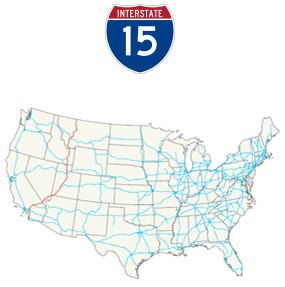
Interstate 15
USinfo | 2012-12-25 16:34

Interstate 15 (I-15) is the tenth longest Interstate Highway, following Interstate 35, and it is the fourth longest north–south Interstate Highway in the United States. I-15 passes through the states of Montana, Idaho, Utah, Arizona, Nevada, and California, and from the Canadian border to San Diego County, close to the Mexican border. This Interstate Highway serves the major cities of Butte, Montana, Salt Lake City, and Las Vegas, Nevada. It also passes close to the urban areas of Helena, Montana, Ogden, Utah, Los Angeles County, California, and Orange County, California.
The stretches of Interstate 15 in Idaho, Utah, and Arizona have been designated as the "Veterans Memorial Highway".
Since the creation of Interstate 15, it has served as a long-haul route for North American commerce. It is now officially chartered for this purpose. From the junction of Interstate 515 in Las Vegas to the Canadian border, I-15 forms part of the CANAMEX Corridor, a High Priority Corridor, as a result of the North American Free Trade Agreement.
Local portions were built to connect the Inland Empire with San Diego in California, facilitate tourism access to Las Vegas, interconnect all of the Metropolitan Statistical Areas in Utah except for Logan, and provide freeway bypasses for Pocatello, Idaho Falls, and Great Falls.
Since the construction of Interstate 15, California, Nevada, and Utah have consistently ranked in the fastest growing areas of the United States. As a result, the route of I-15 has substantially increased in population and commuter traffic has increased the traffic burden on the freeway. Current population estimates are that more than 75 percent of the population of Utah,[4] 19 percent of the population of California, and more than 70 percent of the population of Nevada live in counties where Interstate 15 is the primary Interstate Highway.
Similarly, in California, I-15 is seeing more commuter traffic due to the growth of the Mojave Desert communities of Hesperia and Barstow, California. In all of these states, I-15 has recently been or is currently in the process of being upgraded to increase capacity.
The portions in Arizona, Idaho and Montana have retained their rural, long-haul character. Although Arizona has also grown substantially since the construction of I-15, this highway serves only the isolated corner of northwestern Arizona.
Due to this rapid area growth, the I-15 corridor is the focus of several mass transit projects. The Las Vegas Monorail, FrontRunnercommuter rail system and TRAXlight rail in Salt Lake City are mass transit lines loosely parallel to I-15 that are now in operation. Between Los Angeles and Las Vegas has long been proposed as a maglev train route; in 2004 the California-Nevada Interstate Maglev project held public meetings on the plan.
This highway's southern terminus is in San Diego, California, at Interstate 8, although via California State Route 15, a southern extension of the freeway, the route connects to Interstate 5 just north of the Mexican border.[9] The northern terminus is in Sweet Grass, Montana, at the international border between the United States and Canada, where it becomes Alberta Highway 4. It is 1,433 miles (2,306 km) long from San Diego to Sweet Grass.
History
Interstate 15 was constructed along the route of U.S. Route 91. Once Interstate 15 was relatively intact U.S. 91 was decommissioned, except for one part in Northern Utah/Southern Idaho where Interstate 15 instead followed the route of former U.S. Route 191.
Interstate 15 originally had two suffixed routes. In California, Interstate 15 had an eastern branch bypassing San Bernardino, which was designated Interstate 15E. I-15E was renumbered and is now Interstate 215. Present day routing of Interstate 15 in California was originally given "I-15W" as its title while it was under construction (the original asphalt portions from Temescal Canyon to Ontario Street were dubbed I-15W on maps until 1974 ), but was never officially signed as such .[11] In Idaho, I-15 had a western branch near Pocatello that connected I-15 and I-84 (then I-80N). This highway was designated Interstate 15W. It is now the western I-86.
Future
Redesignation of SR 15 in San Diego as I-15 might eventually occur when the freeway's interchange with SR 94 is upgraded to Interstate standards. The interchange currently has left-exits and blind merges, and is due to be updated with a long-awaited widening of both SR 15 and SR 94 in 2016. At that time SR 15 could most likely be decommissioned and re-signed as Interstate 15.
Share this page



















